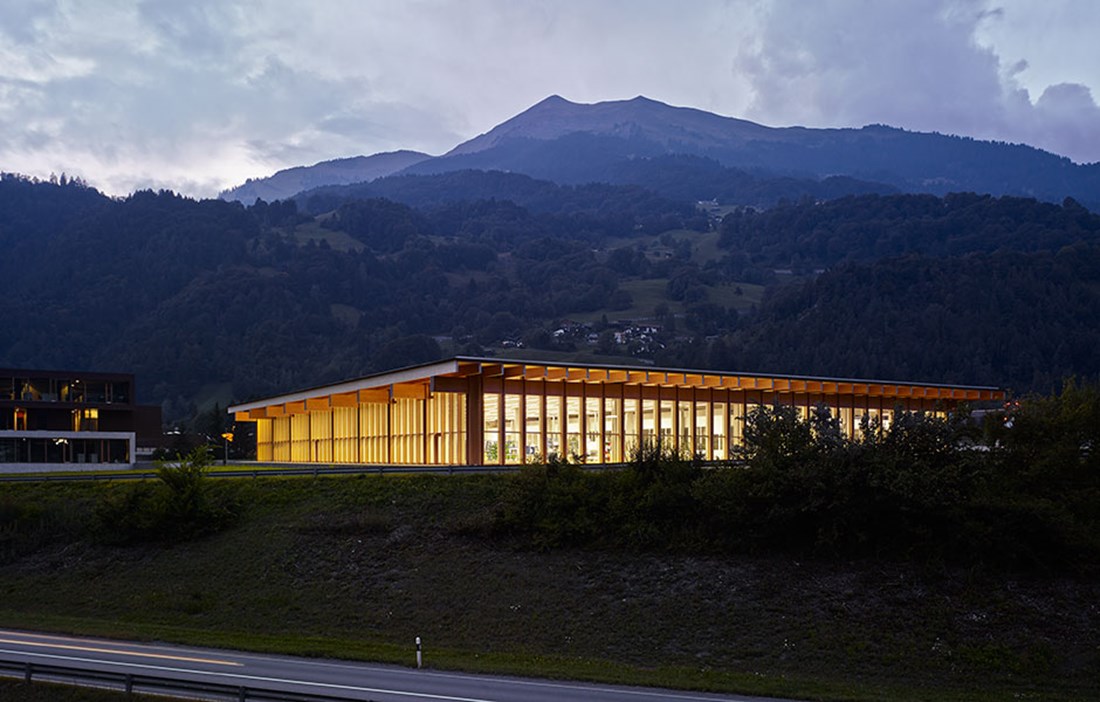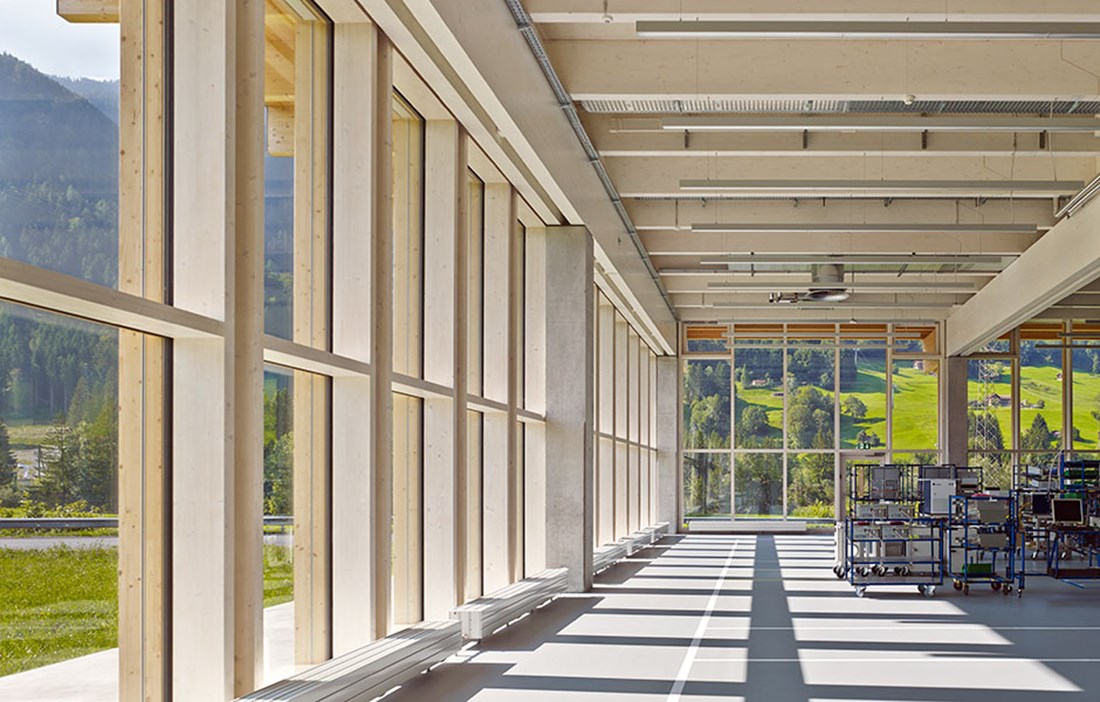FIRM OF ARCHITECTS Barkow & Leibinger’s third contribution to tool manufacturer Trumpf’s research and production complex in Grüsch, Switzerland, adopts classical dimensions and proportions. Tall, narrow windows and a screen of narrow columns support an almost oversized projecting roof structure. It is all a far cry from the usual industrial buildings, whose only criterion is the lowest price possible.
Frank Barkow has no hesitation in comparing the building with Mies van der Rohe’s Neue Nationalgalerie, which is not far from his office on Schillerstrasse in Berlin.
“Our intention from the outset was to make something extremely simple, like a pavilion or a temple,” explains Barkow, who has just returned from the New York office. “For us, it seems only natural to build in wood – it fits comfortably into the ecocycle, it’s easy to work with and it can be used in advanced technical solutions. At the same time, buildings in wood have something classical, almost ancient, about them.”
Barkow & Leibinger is like many young practices, exploring all the latest innovations in architecture and new engineering technology. but in contrast to many colleagues, they appear to be applying the new inventions in project after project. They also pay close attention to the materiality of the architecture, showing a desire to convert new knowledge into artful buildings.
Frank Barkow adjusts his glasses and relates that, in recent years, sustainability has become an increasingly important consideration for the practice. This takes in advanced wood technology, ultra-thin concrete elements and not least the kinetic walls presented at the last Venice Architecture Biennale, which can completely change their appearance with the help of computer-controlled pistons.
“Trumpf wasn’t exactly wild about building in wood – it is, after all, an almost 90-year-old tool company that works mostly in metal,” admits Frank Barkow.
“But in the area of Graubünden there is a very special appreciation of wood that they were compelled to take account of, and since we’d previously used a combined steel and wood design in the factory canteen, there was already a precedent. We were able to show Trumpf that modern technology is at least as high-tech, while also being better for the environment.”
THE TRUMPF PLANT manufactures marking lasers that are used to mark items such as pacemakers. According to Frank Barkow, motorcycle company Harley-Davidson and artists such as Jeff Koons and Kazuo Katase have also made use of the product. Art-related laser marking currently accounts for almost a third of Trumpf’s sales. The company, which was founded in 1923, makes a host of different precision tools, and it is seeing growing demand for its marking lasers. Compared with the previous year, orders were up a massive 70 percent when construction work began in 2012.
The production and research complex in Grüsch was established in the early 2000s, and Barkow & Leibinger were also responsible for the first two buildings. The new production facility adds a further 3,300 square metres to the complex and allows Trumpf to double its production area. Completion of the factory coincided with the company’s production of its 10,000th marking laser in 2013. Frank Barkow explains that the pavilion, which is staffed by around 30 employees, has a simple and extremely flexible layout.
“The building is almost like a temple on its platform, taking pride of place in this beautiful landscape,” says Barkow, who produces a detailed drawing showing how the guttering is concealed in the overhanging roof, which also serves as an adjustable sunscreen.
“It was an easier and quicker build than the previous buildings. The brief was to provide a layout that was flexible enough for the production lines to be reorganised quickly and efficiently.”
THE SLIGHTLY RECTANGULAR building contains a generously spacious and light production hall with a ceiling height of 4.5 metres. Right at the top are the almost entirely hidden steel ties that bind together all the beams of the roof structure. The hall currently houses two production lines for the TruMark marking laser. Next door is a clean room for more sensitive production parts, as well as a packaging room and loading bay. A small office and a conference room complete the building.
“We produced all the structural wood as prefabricated elements at Holzbau Almann’s factory in southern Germany. Once it was all on site, assembly took just four weeks, it was almost a textbook example of construction! The only challenge for the structural engineers was calculating the extreme loads caused particularly by wet snow here at an attitude of 630 metres.”
As well as being part of the natural eco-cycle, wood is also deeply embedded in the Swiss architectural tradition. Nevertheless, the building, with its characteristic facade – a screen of columns spaced 1.5 metres apart with triple-glazing between – is a combination of different materials. A cast concrete slab provides a sharp exterior border and a walkway around the 48 x 68 metre building, while the roof rests on concrete posts as well as the wooden structure. Frank Barkow explains that fire safety is not a problem, since the factory is a single-storey building. He also points out that wood offers a natural way to avoid the problem of thermal bridges, which are created by other materials. Wood is basically self-insulating.
“We’ve used digital technology to finish all the wood for the factory canteen, but otherwise it’s a technically simple structure. There is a very different craft tradition in Switzerland, compared with Germany and particularly the USA, everything is built by skilled craftspeople whose attention to detail covers everything from mechanical systems to door handles.”
Text Leo Gullbring























